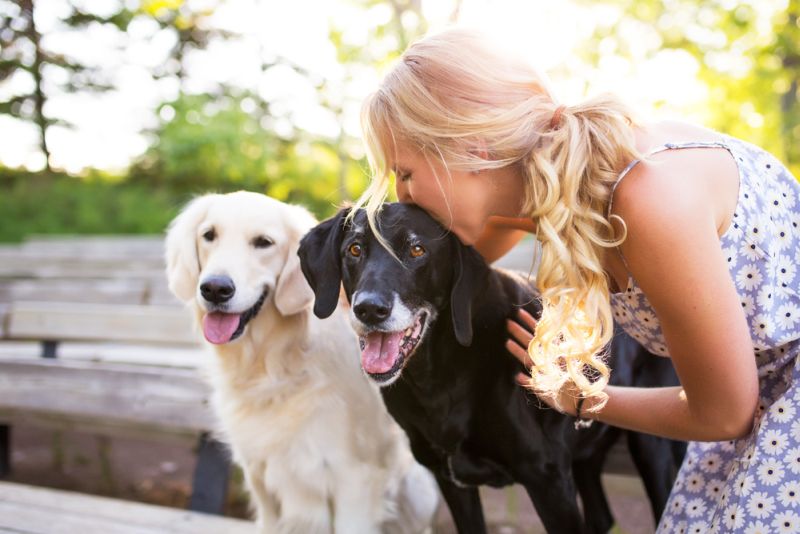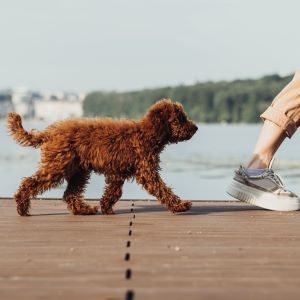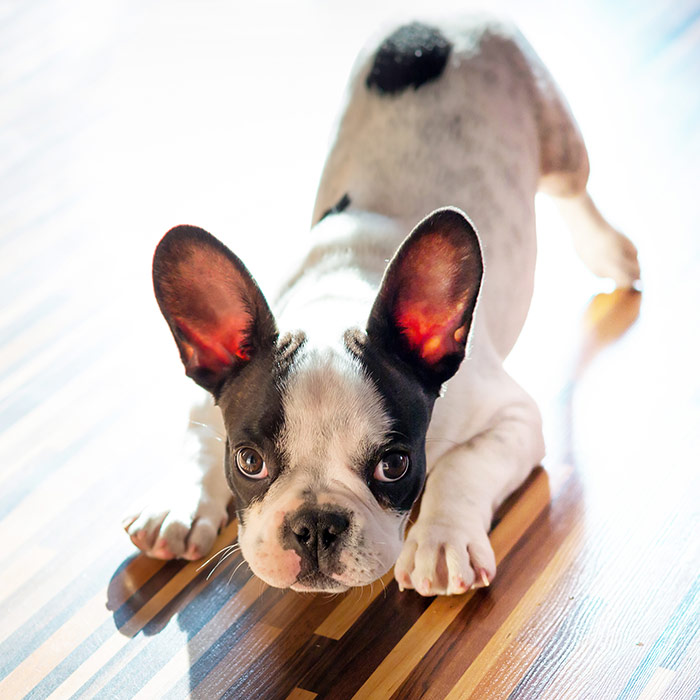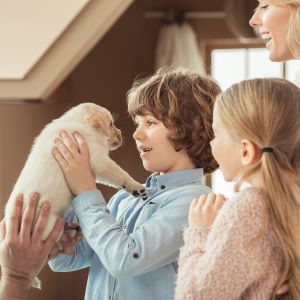How long can you leave a dog or puppy alone?
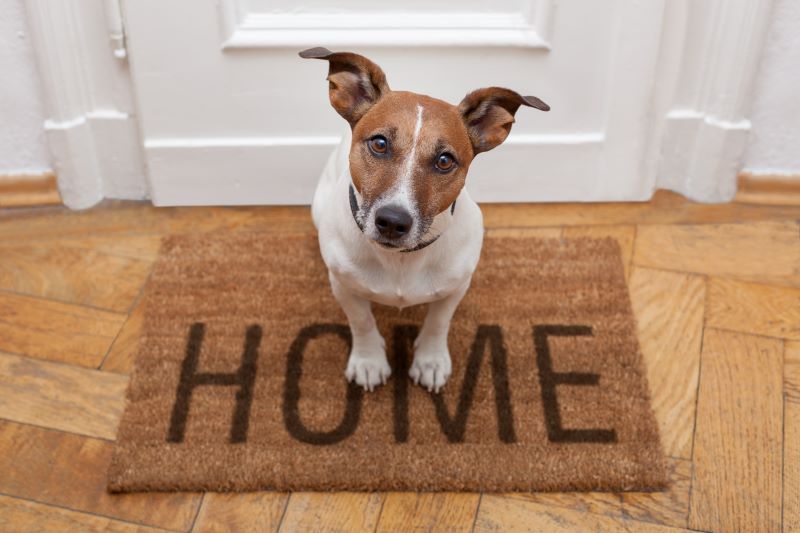
As a pet parent, it’s up to you to ensure the safety and well-being of your four-legged family members. Of course, your responsibilities include feeding and exercising them to ensure their physical health.
Dogs are highly social animals who love companionship and being around you and your family. So, you also need look after their mental health by providing them with the attention and social interaction that they need in order to thrive. This includes making sure that they are not left alone for longer than they can cope with.
How long can you leave a dog or puppy alone? It depends on a number of factors. Many dogs actually need to be taught how to cope with being alone. Read on for our top tips and advice on leaving your puppy or older dog alone at home.
Factors that affect the duration a dog can be left alone
Common questions we hear from pet parents include: How long can you leave a dog alone? How much alone time is too much alone time? How long can you leave a puppy alone?
There are a number of factors that come into play when answering these questions, including their age, health, breed and, for puppies, their potty training progress.
The age of the dog
The amount of time your puppy or older dog can be alone depends on how old they are. Naturally, the younger the pup, the shorter the time they can be left on their own.
Read on for our guidelines for specific ages and duration that dogs can be left alone.
Health condition of the dog
Age is not the only factor to consider. If your dog is sick, or is recovering from an operation or injury, they may require you to be around more frequently, whether to provide medication or help them get around, or if they are more anxious and needy than usual.
Regardless of age, if your dog has been newly adopted, or has been mistreated or abandoned in the past, they may be especially sensitive to being left alone.
The time you can leave a senior dog alone will also be influenced by whether they have any health issues and how often they need to toilet, if they don’t have access to the outdoors (senior dogs normally need to toilet more often).
Unsure how serious it is?
Bow Wow Meow policyholders can get access to trusted vet care anytime, anywhere, at no additional cost. Connect to an experienced Australian registered vet via video call, 24/7. Whether it’s providing vet advice, setting up at-home treatment plans, or confirming if you need to visit a vet in person, you can get help when you need it.
Find out more about our pet insurance cover options.
Breed of the dog
Breed genetics can play a role in determining why some dogs are quicker to adapt than others to being left alone and why some dogs can happily stay on their own for longer periods than others.
Certain breeds with an independent nature, such as Akitas and Malteses, tend to adapt quickly to being alone.
High energy breeds, such as Border Collies, Golden Retrievers, Australian Shepherds and Siberian Huskies, need a lot of daily exercise. Leaving these breeds alone for extended periods might lead to boredom and pent up energy that results in some unwelcome destruction in your home.
Also, some breeds are more nervous than others and may become stressed when left alone for hours every day. Labradors and some of the Terrier breeds, for instance, may experience more separation anxiety when left alone.
Potty training and bathroom breaks
Puppies need to pee a lot. When young puppies are being house trained, they need you, or another responsible person, to be around for bathroom breaks at regular intervals.
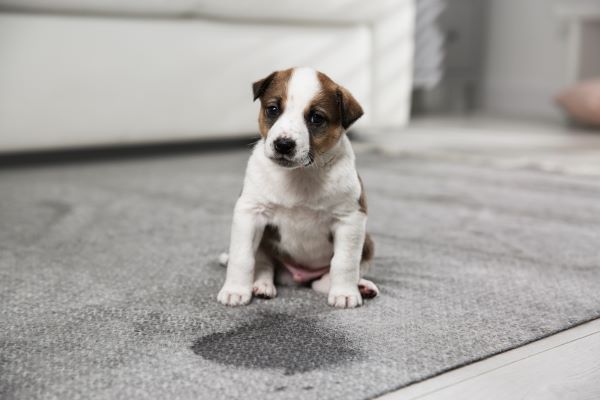
As a broad guideline:
- Puppies younger than 10 weeks old typically can’t hold their bladder for more than an hour
- 10 to 12 week old pups can usually hold it for around two hours
- Three month old puppies can usually hold it for three hours
- After six months, dogs can usually hold their bladder for up to six hours
- Adult dogs shouldn’t be home alone for much longer than six to eight hours without a chance for a bathroom break
- Senior dogs may need to be out more frequently for potty breaks, so going home for lunch or having someone to come by to let the dog out may once again be required.
Once your dog is potty trained, if you don’t have a doggie door, to prevent unwanted accidents you’ll need to come back during lunch or get a family member, neighbour or pet sitter to pop in for a visit and to give your dog outdoor access.
Keep in mind that every dog is different. As the person who knows your dog best, you’ll be able to better understand their needs and adjust accordingly.
Safe duration for leaving your dog alone
The broad guideline for leaving a puppy alone during the day is one hour for every month of age. This is a generalisation based on the length of time they should be able to hold their bladder, but it’s a good starting point.
| Age of dog: | Safe duration to be alone: |
| 8 to 10 weeks | Up to 1 hour* |
| 10 to 12 weeks | 1 to 2 hours* |
| 3 months | 3 hours* |
| 4 months | 4 hours* |
| 5 months | 5 hours* |
| 6 months | 6 hours |
| Over 6 months | Maximum 6 to 8 hours |
Younger puppies should be left for up to the suggested time period for their age in a crate, play pen or safe puppy-proofed room (see below).
Be patient with this process. Being able to leave your dog alone for more than a few hours can take up to six months, and sometimes longer!
Ways to ensure your dogs are safe while you’re away
Create a safe space for your puppy
Create a space where your puppy will not only be safe, but will feel safe. To do so, you can use a playpen or crate, or cordon off a small section of your house with baby gates. Fill the space with their favourite toys and cosy blankets so they know it’s a place they can go to relax.
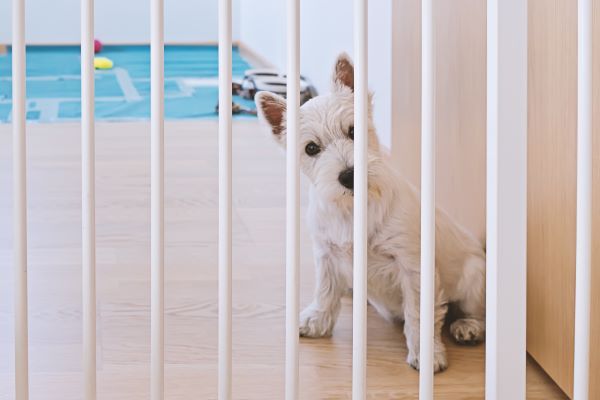
Feed your pup meals and treats inside this space to help them see it as something positive. If the area is large enough, you can spend some time playing there with them. You can also set aside special toys that they only get inside their space, so it’s seen as a reward.
Crate training can be a powerful tool to help your pup relax when they’re sleeping or being left home alone. However, this doesn’t mean you can or should leave them in a crate all day. Crates should be used as a temporary safety and house-training measure until your pup is able to roam the house freely.
If your puppy is older and has been house trained, you can set up a larger gated area for them to be in when they’re alone. This gives your puppy more room to move around and space to explore. Make sure that no dangerous items are around, such as cords that your puppy could chew on.
Get someone to check up on them
Puppies are social animals, so they don’t respond well to being alone for long periods of time. Having a pet sitter or someone you know, such as a friend or neighbour, spend time with your puppy when you’re working is a great way to lower the risk of boredom or separation anxiety. If possible, have someone stop by every couple of hours while you’re gone if your puppy is younger. As your puppy gets used to being left alone, you can have these visits occur less often during the day.
Training your dog to be left alone
Learning to be alone is an important part of your puppy’s training and can help lessen separation anxiety. Without this training, it’s easy for your dog to get bored and stressed, often leading to behavioural issues, damaged furniture, or the destruction of anything else they can get their noses into!
On the other hand, with time, patience and effort, you can help your pup or adult dog feel calm and confident when they’re left alone.
With a special space set up for your puppy to be in, you can begin their separation training.
Start by encouraging your pup into their space with a chew toy or enjoyable activity, like a treat puzzle. Quietly walk out of the room, before returning about 10 to 15 minutes later and praising them. Repeat the process, gradually increasing how long you’re away, to teach your dog that you will return.
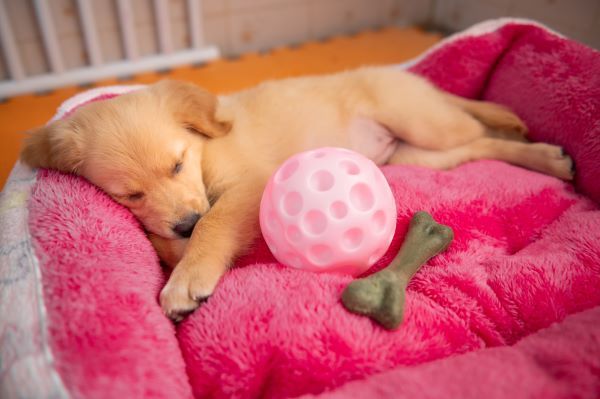
As the time between leaving and returning gets longer, return to check on them every now and then. If they are quiet, reward them with gentle praise and a treat before you leave again, making sure you aren’t loud or making too much of a fuss.
If your puppy cries or whines when left alone in their safe space, don’t make a habit of letting them out when they fuss. Instead, shorten the time of their confinement and then slowly build up again.
Remember that the pen or crate is only temporary. When you feel confident that your puppy is okay on their own – and won’t tear up your house – you can start giving them more access to your home, one room at a time.
Ensuring your dog is never left alone for too long
Separation anxiety can develop when puppies and older dog are left alone, especially for long periods of time. Puppies with this problem may eliminate indoors, bark excessively, chew up clothing or furniture or exhibit other behavioural issues.
If your dog shows signs of stress or anxiety, reduce the time they are left alone until they can remain calm and relaxed. Then slowly increase the time you are away.
Dogs that have separation anxiety will need some human company more often than calm dogs that just relax until you come home at the end of the day. Having someone stop by to see your puppy every few hours while you’re at work all day can help prevent this from happening.
Tips for keeping your dog entertained while you’re away
A bored, lonely dog can easily become a stressed and destructive dog – especially since their biggest source of entertainment is you. However, there are some helpful tools and tricks that can help keep them happy and stress-free when home alone.
Don’t leave your pooch with toys that can easily be chewed or torn apart, since these could be dangerous.
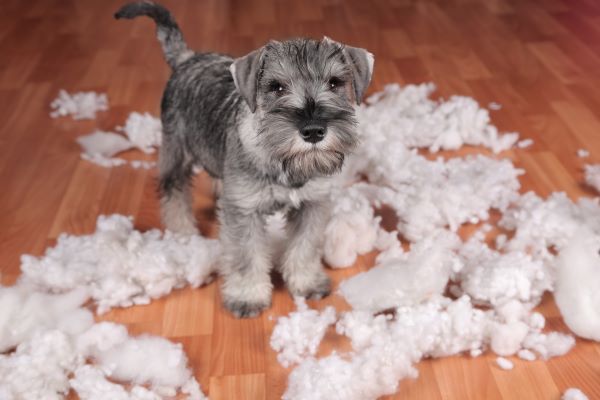
Rather, provide them with sturdy, safe toys to chew on, and consider using puzzle toys. Interactive toys require your dog to figure out how to get to treats that are stuffed or hidden inside them and can keep many dogs entertained for longer periods.
Our top suggestions:
- Leave out a few of their favourite toys
- Set up treat puzzles and interactive toys
- Get creative with their treats by freezing them on a hot day (e.g. banana-stuffed Kongs or similar)
- Set up their bed near the window to encourage them to watch the world outside
- Set up a screen with YouTube for dogs
- Provide music and other noise distractions
Keeping your dog stimulated as much as possible while you’re away is the best way to prevent trouble. While puzzles, toys and treats won’t replace a good old walk in the park or play session with their favourite humans, they will help keep your puppy entertained, alleviate boredom, and can help them pass the time while you’re gone.
Importance of meeting your dog’s physical and emotional needs
Puppies and young dogs often need more enrichment than adults. Without it, they may become bored, and even destructive, when left alone. Enrichment can be provided via a training session, an interesting walk, or a round of games.
Probably the best advice is to feed, exercise, and play with your dog before leaving them alone. In fact, leaving your puppy or active adult dog alone without tiring them out can be a recipe for disaster. Often, a hungry or bored puppy will look to fulfil their own needs when alone.
More helpful tips:
- Leave a shirt or pillow with your scent on it with your pup so they can enjoy some comfort from it.
- Create a cosy environment for your dog, with a soft bed and comfortable temperatures.
- Get to know what your dog prefers and try to offer them the right environment. For example, some prefer having a TV or radio on when you’re away, while others prefer silence.
- Set up a pet camera to monitor your dog’s behaviours when they are alone.
Spend quality time with your puppy when you’re home
Puppies and dogs in general are highly social and prefer human company and spending time with their family to playing on their own. When you get home from work and when you’re home on the weekend, make sure that you have plenty of playtime and just hanging-out-together time.
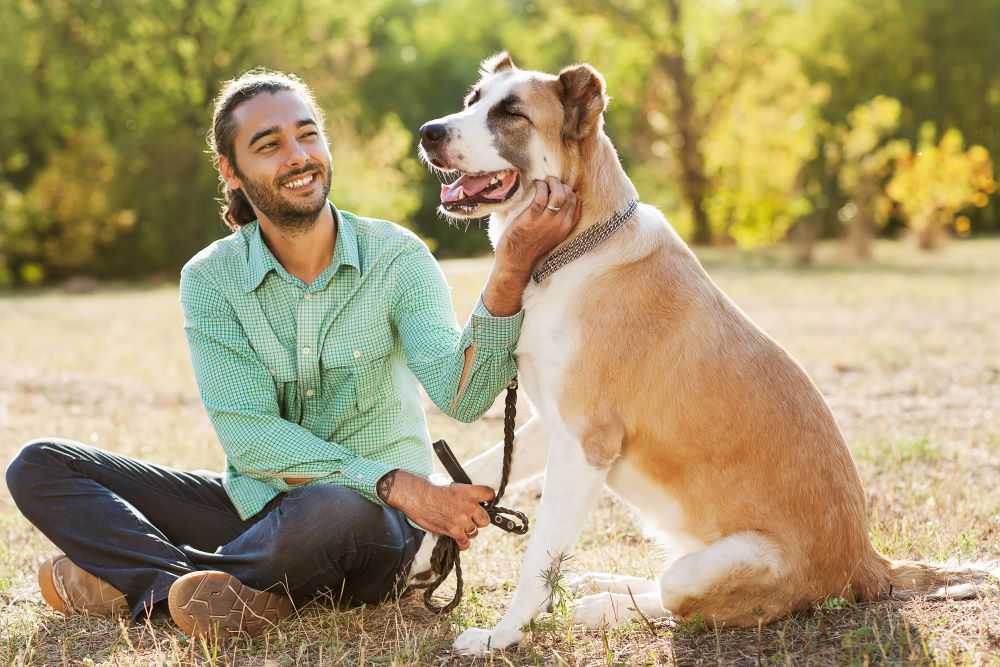
Conclusion
Dogs are highly social animals who love human interaction and are happy when around you and your family. As pet parents, we need to provide them with the attention and social interaction that they need in order to thrive.
However, we can’t be with our pets 24/7, so it’s up to us to teach them how to cope with being alone, as well as making sure that they are not left alone for longer than they can cope with.
Other tools and tricks that can help your dog through alone time include exercising or playing with them before you leave, using food dispensing toys to keep them entertained for a period and making sure their accessible space is safe, secure and inviting, with somewhere comfy to sleep and some favourite toys. Access to fresh water as well as a place to toilet are, of course, essentials.
FAQ
How long can I leave my puppy alone?
Young puppies aren’t used to being alone, and they also need to toilet often. While a broad guideline is that you can leave them home one hour for every month of age, the length of time will depend on how long they can hold their bladder. When they reach the six-month mark, some puppies are happy to be left alone for up to 8 hours.
Can I leave my adult dog alone for 8 hours?
Generally, the maximum time for dogs over 6 months to be alone is 8 hours, provided the dog has a way to get outside for a toilet break. However, all dogs are different, and factors such as your dog’s age, breed, and personality may play a role. If possible, have someone check on them from time to time.
Can I leave my dog alone with food and water?
While you’re away for the day, be sure your dog always has access to fresh, clean drinking water. Food is not required between meals, but it can be provided in puzzle toys – an enjoyable and rewarding activity that will occupy your dog for a period of time. Just be careful not to overfeed your dog if they have a tendency to gain weight.
Do not leave your dog home alone overnight. Dog sitters are a must if you are going to be away for longer than 8 hours.
Should I crate my dog when I leave them alone?
Crate training can be a powerful tool to help your puppy relax when they’re sleeping or left home alone for short periods. However, do not leave them in a crate all day. Crates should be used as a temporary measure while you build up enough trust to let your pup roam the house freely.
Can I hire a dog walker or pet sitter to check on my dog while I’m away?
If you’re not able to personally go home to give your dog a break, a dog sitter is a great alternative. The dog sitter can keep your puppy active while you’re away, and reduce your stress about leaving them alone.
Bow Wow Meow Pet Insurance can help protect you and your dog should an unexpected trip to the vet occur.
-
Find out more about our dog insurance options
-
Get an instant online pet insurance quote







